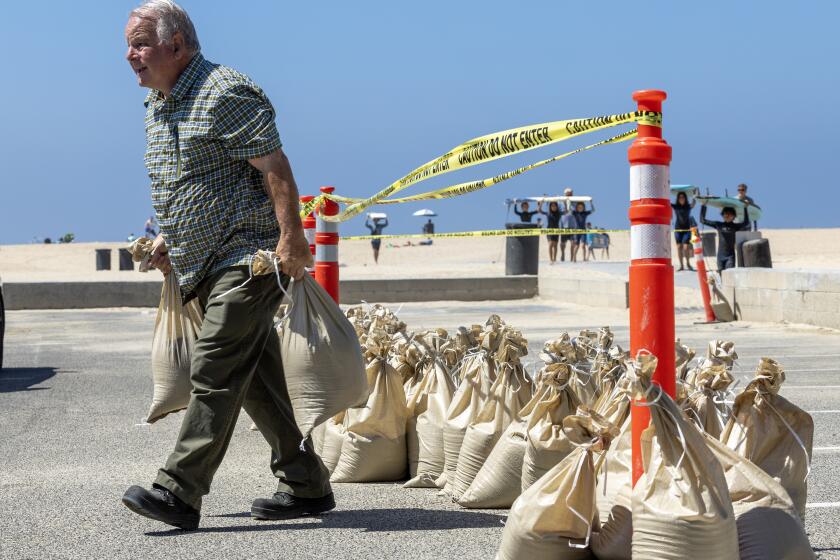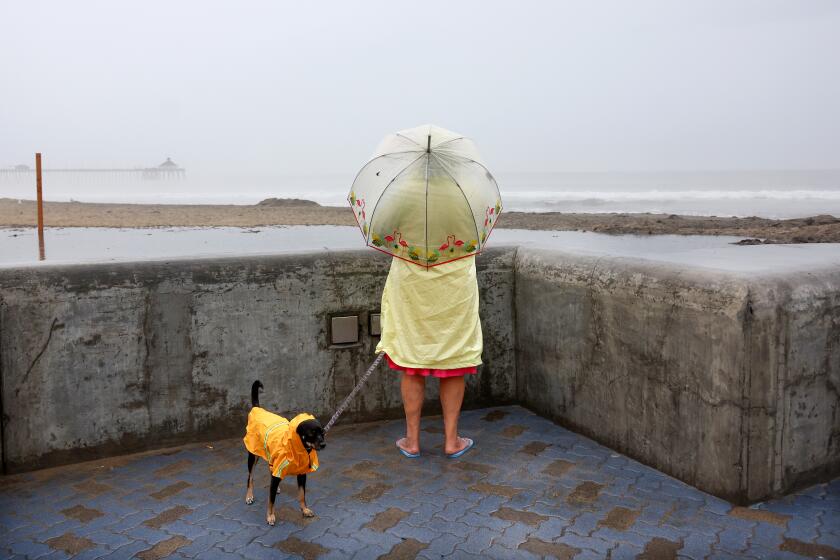Checklist: What to have in your emergency kit ahead of the tropical storm

- Share via
Hurricane Hilary has worked up to a Category 4 hurricane. By the time it reaches Southern California, it’s expected to be a tropical storm. Are you ready?
You should have an emergency kit on hand for when disaster strikes. You need food and water, as well as supplies to potentially get by without electricity or running water — or on the road if you need to evacuate.
Experts recommend keeping your earthquake kit next to or under your bed, tied to the leg. That way, if an emergency happens when you’re sleeping, you’ll have it all right there and easy to find, even in the dark.
If you don’t have storage space under your bed, at minimum disaster readiness experts say you should have what’s known as a “by-the-bed” kit: A flashlight, a pair of hard-soled shoes, and a pair of glasses or contacts under your bed or in a nightstand drawer. The idea here is that even if there’s debris or broken glass on the floor, or the power is out in the middle of the night, you’ll be able to get from your bed to wherever your quake kit is quickly and safely.
The items on this list will apply for all types of natural disasters. Generally speaking, if you’re ready for a flood, you’re ready for earthquakes and fires too. For this weather event specifically, some municipalities — including Riverside, Long Beach, and Yucca Valley — are handing out sandbags at fire stations or other locations. You can call your local fire station or city government, or check their website or X (formerly Twitter) account to see if they’re offered in your area.
Hurricane Hilary is a reminder to sign up for services that alert you when storms, extreme heat, earthquakes, tsunamis or fires threaten or hit an area.
List: What to have in your emergency kit
— Canned and packaged foods (the Red Cross recommends having a two-week supply for your household)
— At least three gallons of water per day, per person (also a two-week supply)
— Fire extinguisher
— Hard-soled shoes
— Extra glasses/contact lenses
— Seven-day supply of medications, especially prescription
— Face mask
— Cash (credit card readers may not work if the power is out or the network is unavailable)
— Sanitation and personal hygiene items (including toilet paper and menstrual supplies)
— Whistles
— A list of phone numbers for family and emergency contacts (written down in case your phone battery dies)
— Utensils
— Manual can opener
— Paper map of your area
— Scissors
— Duct tape
— Food, medication, restraints and other supplies for pets
— Copies of important documents, such as emergency contacts, passports, driver’s licenses, birth certificates and insurance policies
— Diapers, formula, food and medication for small children
— Comfort items, such as stuffed animals, board games and books
— Hand-crank NOAA radio
— Flashlights
— Batteries for flashlights
— Phone chargers
— Hard hat or helmet
— Gloves
— Goggles
— Crowbar
— First aid kit
— Multipurpose tool that can turn off utilities
— Heavy-duty plastic garbage bags (for waste, tarps, rain ponchos and other uses)
— Blankets
— Sleeping bags
— Extra clothing for a variety of weather
— Tent
— Portable cooking appliance, such as a propane camp stove
Hurricane Hilary is likely to make landfall in Los Angeles as a tropical storm, bringing heavy rains and potential flooding. Here’s what you can do now to prepare, and how to stay safe when the storm arrives.
Why do I need this stuff in my emergency kit?
Some of the things on this list might be unfamiliar. Here’s an overview and why you should have them.
Hand-crank NOAA radio: You can listen to National Oceanic and Atmospheric Administration Weather Radio online whenever you want, if that’s something that interests you. But in the event of a disaster, cell towers could stop working. And if you’re using your phone a lot, your battery could go even sooner than that. If your modem’s power is out and you’re using cell service at the exact same moment as every other person in your house, neighborhood and city, livestreaming radio might not be available.
A hand-crank NOAA radio will let you tune in for weather alerts and other updates. Most modern options have presets to access NOAA frequencies (162.550 for Los Angeles). Radios with NOAA receivers are different from the radio in your car: They broadcast on a VHF frequency, as opposed to AM or FM. (It’s complicated.) Many also can be charged with solar power or batteries, and let you use that power to charge your phone at the same time. Some double as flashlights. You should really get one.
Tune your radio to your NOAA station and practice using the hand crank and other functionalities. And make sure you have the right kinds of cables to charge your devices from the radio, if that’s a feature yours has.
Another good way to stay up to date if you live in Los Angeles: Sign up for emergency alerts.
Whistles: If you’re trapped and need emergency workers to find you, blowing a whistle is going to be louder and more sustainable than shouting. You can get a shockingly loud emergency whistle for just a few dollars.
Paper map: Sure, you know how to get around your neighborhood. But would you know how to navigate to a new address (for instance, a shelter, hospital or emergency supply depot) in a different part of the city if all the freeways were at a standstill and you couldn’t use your phone? Unless your answer to that question is a resounding “yes,” add a paper map of your area to the kit.
If you have not used paper maps much before, it’s a good idea to unfold it and mark where your house is, so you know your starting point, and highlight the nearest couple emergency rooms.
Plastic sheeting and duct tape: These are for securing your shelter in the event of structural damage. You might need to tape off certain areas so you can safely move around, or put sheeting down over shattered glass, or use it to cover broken windows or doors.
More helpful advice
Make sure your food and water are a ways off from their expiration dates. Plastic water bottles can leak over time, so be careful how you store them, and rotate your water supply every few months. Have fresh batteries and extras for the flashlights. Double-check that you have chargers for everyone’s phones.
After your kit is assembled, you’ll need to rotate perishable items such as food, water and batteries according to their expiration dates. Set a calendar reminder to check regularly.
An unprecedented tropical storm warning is in effect from the California-Mexico border to Point Mugu and for Catalina Island.
More to Read
Sign up for Essential California
The most important California stories and recommendations in your inbox every morning.
You may occasionally receive promotional content from the Los Angeles Times.

















